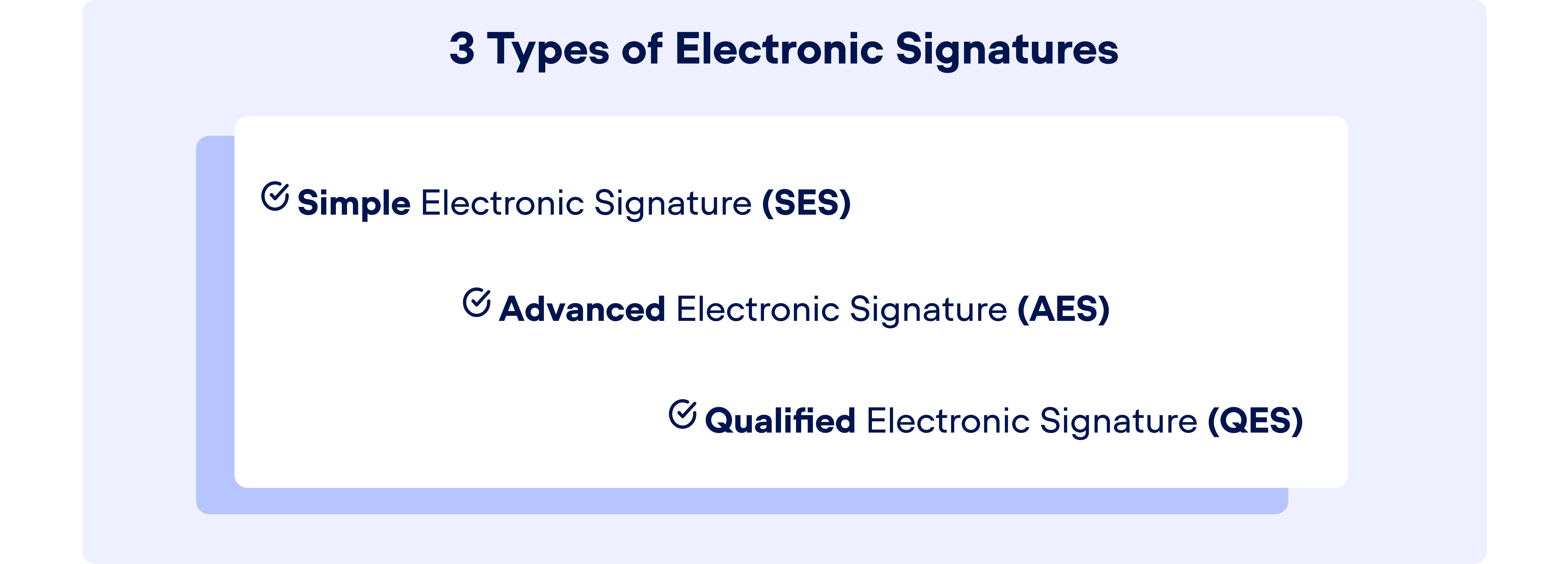What are the 3 Types of Electronic Signatures and How to Choose One?
Table of contents
- Definition of Electronic Signatures
- Types of Electronic Signatures Explained
- The Legality of E-signatures
- How to choose the right Electronic Signature type?
- Types of E-Signatures - Conclusion
-
About Concord
Effortless contract management, from drafting to e-signing and beyond. Book a live demo to see Concord in action.
Book a demo
Are you looking to make your business more efficient with the help of digital technology? E-signatures offer a way to do just that; however, understanding their different types can be slightly overwhelming.
In this blog post, we’ll discuss the 3 types of electronic signatures so you know exactly which one is right for your organization’s needs. We’ll cover details including when each kind should be used and their advantages and disadvantages relative to other choices available.
By understanding the nuances between them, you will have all the information necessary to make an informed decision on which e-signature type will work best for your business!
Definition of Electronic Signatures
Electronic signatures are signatures that are created, transmitted, and recorded in electronic form. E-signatures are legally binding and have the same power as handwritten signatures. Unlike the handwritten kind, e-signatures use data in electronic form to represent the signature.
E-signatures can take many forms, from an electronic representation of a handwritten signature to a typed name or a checkmark on a digital document. They make it easier and faster to sign important contracts or agreements no matter where you are in the world.

Types of Electronic Signatures Explained
Not all e-signatures are created equal. There are three main kinds available, each with varying levels of security and legal weight.
The 3 types of e-signatures are:
- Simple Electronic Signatures (SES)
- Advanced Electronic Signatures (AES)
- Qualified Electronic Signatures (QES)
Understanding the different kinds of electronic signatures can help ensure that your signature is legally binding and secure.
1. Simple Electronic Signatures (SES)
Simple Electronic Signatures (SES) are the most basic form of e-signatures. They provide a digital representation of a person’s agreement or consent on electronic documents. They can be created by simply typing a name, scanning a handwritten signature, or clicking an “I Agree” checkbox.
Commonly used in everyday transactions and low-risk agreements, SES enable efficient and paperless signing processes for both businesses and individuals.

SES Specifications and Requirements
Unlike Advanced or Qualified Electronic Signatures, Simple Electronic Signatures do not require strict identity verification or security measures. They are considered “simple” due to their minimal security features and ease of use.
However, it is important to note that the legality and acceptance of SES may vary depending on the jurisdiction and the specific document being signed. In some cases, stronger digital signatures with higher levels of security and authentication may be necessary to comply with legal requirements.
SES Examples
Simple Electronic Signatures are often utilized in scenarios such as:
- signing electronic consent forms,
- non-disclosure agreements,
- and internal company documents.
Industries driving their adoption include real estate, human resources, sales, and legal services. For example, property managers may use SES for lease agreements, while HR departments may use them for employee onboarding paperwork.
Advantages and Disadvantages of SES
The primary benefit of Simple Electronic Signatures is their ease of use and ability to expedite signing processes. This results in increased efficiency and reduced reliance on paper.
However, the main disadvantage is the lower level of security and authentication compared to Advanced and Qualified Electronic Signatures. This makes SES more susceptible to forgery and disputes, particularly in high-risk transactions or when dealing with sensitive information.
Therefore, it is crucial to carefully assess the appropriate type of e-signature based on the specific use case and legal requirements.
2. Advanced Electronic Signatures (AES)
Advanced Electronic Signatures (AES) are a more secure and reliable kind compared to Simple Electronic Signatures. They require authentication of the signer’s identity and establish a clear link between the signature and the signed document.
AES provide an added layer of trust and assurance in digital transactions. Because of that, they are commonly used for legal documents, financial transactions, and contracts that require higher levels of security and authentication.
AES specifications and requirements
To be considered “advanced,” e-signatures must meet specific technical requirements and legal stipulations. These include
- unique identification and authentication of the signer,
- the ability to detect any changes made to the document after signing,
- and ensuring the signature is linked to the signed document in a way that demonstrates its validity.
While AES offers enhanced security compared to Simple Electronic Signatures, they are not as strict and secure as Qualified Electronic Signatures, which involve additional steps such as obtaining a digital certificate from a qualified trust service provider.
AES examples
Advanced Electronic Signatures are typically utilized in situations where a higher level of security and authentication is required. Examples include
- signing legally binding contracts,
- loan agreements,
- and other financial documents.
Users and businesses that may utilize AES include law firms, financial institutions, healthcare providers, and government agencies, among others.
Advantages and Disadvantages of AES
The primary advantage of Advanced Electronic Signatures is their enhanced security features. They provide greater trust and reliability compared to Simple Electronic Signatures. By requiring identity verification and establishing a clear link between the signature and the signed document, AES reduces the risk of forgery and disputes. Additionally, AES offer a balance between security and ease of use, making them suitable for a wide range of applications.
However, it is important to note that in cases with strict legal requirements or high-value transactions, Qualified Electronic Signatures may be necessary for optimal security and compliance.
3. Qualified Electronic Signatures (QES)
Qualified Electronic Signatures (QES) represent the most secure and legally binding form of e-signatures available. They require strict authentication measures and are backed by a digital certificate issued by a qualified trust service provider.
QES are not as commonly used in everyday business transactions as Advanced Electronic Signatures due to their stringent requirements and more complex implementation process.
QES Specifications and Requirements
To be classified as “qualified,” e-signatures must adhere to specific technical and legal requirements, which include:
- obtaining a digital certificate from a qualified trust service provider,
- using a secure signature creation device,
- and ensuring the signature meets the standards set by relevant regulations, such as the European Union’s eIDAS regulation.
The strict requirements for QES differentiate them from other kinds of e-signatures, providing the highest level of security and non-repudiation.
QES examples
Although not as common in everyday business transactions, Qualified Electronic Signatures are often used in situations with strict legal requirements or high-value transactions involving sensitive information. Examples include
- signing land registry documents,
- filing patent applications,
- or submitting legal documents to government agencies.
Due to their strict security measures, QES are primarily used by organizations and individuals that require the utmost assurance in the validity and integrity of signed documents.
Advantages and Disadvantages of QES
The main advantage of QES is their unparalleled security and legal compliance, providing the highest level of trust and assurance compared to Simple and Advanced Electronic Signatures. This makes QES particularly suitable for high-stakes transactions and situations with strict legal requirements.
However, the primary disadvantage is their complexity and the additional steps required to obtain and maintain a digital certificate from a qualified trust service provider. This may deter some businesses from adopting QES, opting instead for the more commonly used Advanced Electronic Signatures, which offer a balance between security and ease of use.
The Legality of E-signatures
E-signatures, including the simple, advanced, and qualified varieties, are legally recognized in both the European Union (EU) and the United States (US).
In the EU, the eIDAS regulation standardizes the rules for electronic signatures, ensuring their legal validity and cross-border recognition. Under eIDAS, all three e-signatures types are legally binding, but advanced and qualified e-signatures provide higher levels of security and are often required for specific transactions or documents.
In the US, the Uniform Electronic Transactions Act (UETA) and the ESIGN Act govern the legality of e-signatures, granting them the same legal status as traditional wet-ink signatures.
However, it is important to note that different kinds of e-signatures have varying legal standing, depending on the specific use case, risk level, and jurisdiction. Some transactions may require additional verification, such as identity authentication or digital certificates, to ensure compliance with relevant regulations and legal requirements.
How to choose the right Electronic Signature type?
Choosing the right kind of e-signature for your business can be a difficult decision, as each kind offers different levels of security and ease of use.
Simple E-signatures are convenient and easy to use, but they may not provide enough protection for sensitive transactions or documents. Advanced Electronic Signatures offer greater security than Simple E-signatures and are often used in high-risk situations such as financial transactions. Qualified Electronic Signatures, on the other hand, provide an extra layer of security by using digital certificates from qualified trust service providers. However, QES requires additional steps to obtain and maintain a certificate which may deter some businesses from adopting it.
Advanced Electronic Signatures are the most popular choice for businesses seeking secure and legally binding signatures. AES provide the highest level of security, and are trusted by many organizations as a reliable method for authentication. They also offer more flexibility than Qualified Electronic Signatures, as they do not require extra steps to obtain or maintain a certificate. AES are the best choice for most businesses, offering an effective and reliable way to securely sign documents efficiently.
Types of E-Signatures – Conclusion
E-signatures are a safe and secure way to sign documents and have gone beyond simple pen-and-paper routines. While all kinds of digital signatures are legally admissible, the best option is to select the most secure kind that fits your needs, either Advanced Electronic Signatures or Qualified Electronic Signatures.
You should also enjoy the benefits offered by a CLM platform like Concord that can help manage business operations from anywhere in the world. Concord offers unlimited, secure e-signatures, as well as other features that support end-to-end contract management. So go ahead and try out Concord today!
Sign up for a free trial now to experience the power of secure E-Signing technology!




